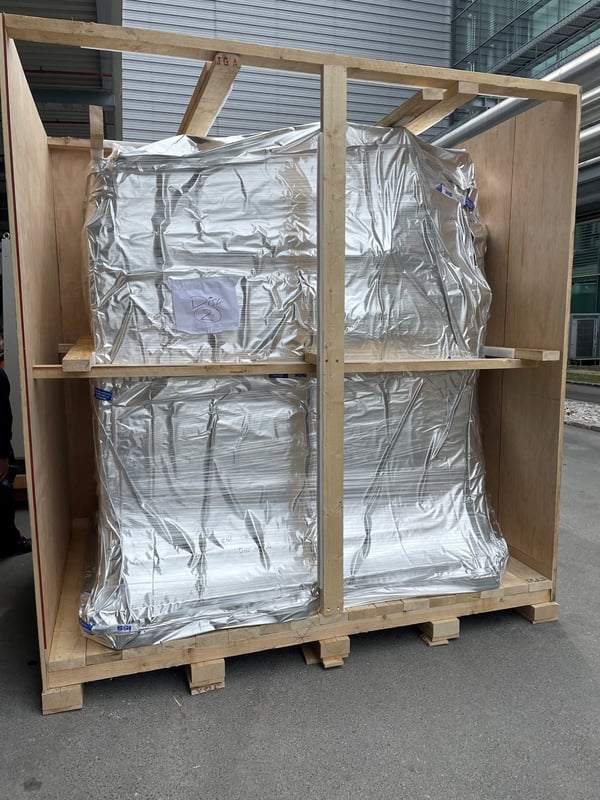How a semiconductor tool is packed directly influences its long-term performance, longevity and reliability.
A poorly packed tool could sustain potentially fatal amounts of damage during transit, as well as be introduced to dangerous levels of contamination and electrostatic discharge (ESD).
Whereas a well-packed tool will be shielded against external influences that could degrade its performance or lead to failures.

The SEMI Packing Standards define and regulate the processes and materials involved in semiconductor packaging and the handling of semiconductor tools.
They’re widely adopted by manufacturers across the semiconductor industry and supply chain, and for many, serve as best practices for semiconductor packing.
At IES, we adhere to the SEMI Packing Standards for all semiconductor-related projects.
Here’s what you need to know about the standards, what they cover and the key benefits of adhering to them.
What are the SEMI Packing Standards?
The SEMI Packing standards are set by the SEMI Association, a global industry association that represents companies involved in the electronics manufacturing supply chain.
They were established to define, standardise and regulate the processes and materials involved in packing semiconductor tools and components.
Standardising these processes helps ensure that:
- Packing materials are suitable for the unique requirements of semiconductor tools and meet stringent quality criteria.
- Materials and components are handled and stored in a way that minimises the risk of contamination, damage and other potential issues.
The standards also provide a common framework and language that manufacturers, suppliers and logistics partners across different regions can understand and follow, facilitating seamless international trade and cooperation.
Here are some of the key factors that the standards cover:
- Material specifications: Packing materials, such as tapes, trays and carriers, should meet the specified standards for quality, durability and contamination control.
- Packaging design: Semiconductor packing materials should adhere to defined specifications for size, shape and container structure. This helps protect against contamination, electrostatic discharge (ESD) and physical damage during transport.
- Handling and storage: Handling of packing materials should meet guidelines for material handling, optimum storage conditions and protection against environmental factors to protect them against defects and contamination.
- Labelling and identification: Packing materials should be clearly and accurately labelled to allow for traceability, proper handling guidelines to prevent damage and easy identification throughout the supply chain.
- Cleanroom compatibility: Packing materials should comply with cleanroom cleanliness requirements to prevent contamination of sensitive semiconductor materials during transportation and storage.
- Transportation: Semiconductor packages should be stacked, stored and shipped according to specialised guidelines to minimise risk and prevent damage during transit.
Our experts can support your semiconductor relocation project in any way you need. Learn more here.
Why is the SEMI Packing Standard important?
Here are a few key benefits of adhering to the SEMI Packing Standard.
Quality and reliability
Semiconductor components are highly sensitive to environmental factors, contaminants and physical damage. And even the smallest amounts of damage can cause significant defects and failures in the long term.
High-quality packing protects a semiconductor tool from sustaining damage during transit, as well as adheres to cleanliness standards, preserving tool quality, reliability and shelf life.
![]()
Efficiency
When you lack a standardised process for handling, storing and transporting semiconductor packing materials and components, you risk being held back by operational efficiencies.
The SEMI Packaging Standards streamline the semiconductor packing process, reducing lead times and enhancing efficiency.
Compatibility
The semiconductor industry is global, with manufacturers, suppliers, and customers located in various regions. Without a common set of standards, working together can result in miscommunications, compliance risks and supply chain disruptions as a result of compatibility issues.
The SEMI Packing Standards establish a common language and set of guidelines that everyone in the supply chain can understand and follow. This simplifies international trade, reduces misunderstandings and facilitates smoother interactions between stakeholders.
Best practices
Regulatory authorities often align their requirements with the SEMI Packing Standards standards because they represent established guidelines and best practices for quality, safety and reliability.
Adhering to these standards helps manufacturers and suppliers demonstrate a commitment to following industry-accepted best practices.
Sustainability
SEMI Packing Standards support sustainability initiatives by promoting efficient and responsible packaging practices in the semiconductor industry.
These standards encourage reduced material waste, energy efficiency, recyclability, transportation efficiency, durability, and global standardisation. By adhering to SEMI standards, semiconductor companies can contribute to reducing their environmental impact and embracing more sustainable business practices.
Pack and ship semiconductor tools with total confidence
For more than 30 years, we’ve been working with complex semiconductor tools (from implanters to lithography) in fabs all over the world.
Whether you just need support packing or shipping your semiconductor tool, or you’re looking for a full relocation service, our experts are on hand to support your project in any way you need.
Learn more about how we can support your semiconductor tools here.




